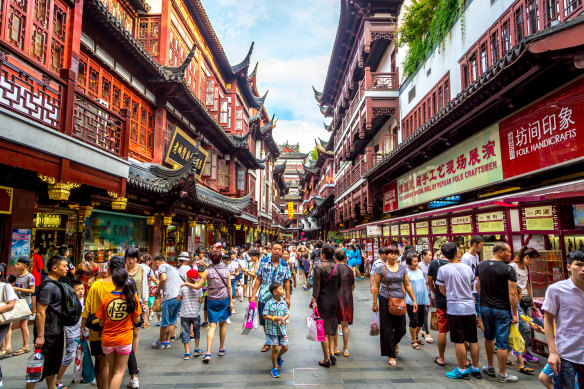Opinion
Visa-free or not, few Australians want to go to China
Lee Tulloch
Travel columnistSo, nobody wants to go to China.
Last month the Chinese government, on a panda diplomacy tour of Australia, announced it will grant Australian travellers visa-free entry for 15-days. The program began at the start of this month.

Shanghai shopping.Credit: iStock
It’s an attempt to ramp up inbound tourism, which has been seriously flagging since the pandemic. Foreign visitors are arriving at only 30 per cent of 2019 levels, even though domestic tourism is booming.
I was in Shanghai late last year when Qantas reinstated its convenient non-stop flights, which now sadly have been halted due to lack of interest. I wondered why Australian tourists aren’t so keen on China now.
I love Shanghai and I’ve been several times. I was daunted by the DFAT warnings that Australians may be subject to “arbitrary detention” or harsh enforcement of local laws but my burning curiosity about what it would be like after the dramatic COVID-19 lockdowns won me over.
The biggest hurdle has always been the visa application process. Tourists needed to negotiate long lines at visa application centres, rigorous demands (the photo requirements are especially irksome) and scrupulous questioning of itineraries and professions.
But when I applied a few months ago, even though the lines at the Sydney visa centre were still painfully slow, I was barely questioned once I reached the counter. The immigration officers were spending far more time with Chinese Australians than anyone with non-Chinese ancestry. I picked up my visa within two days.
Getting a visa is one thing. Fronting immigration on arrival at the destination is another. This time, it did not go smoothly. The uniformed officer behind the counter seemed puzzled by my passport and kept on consulting his computer and tapping in figures, looking stern.
When he asked me to wait while he consulted a superior, I admit I started to tremble. My fellow travellers waved as they went through without a hitch, and I worried I may never see them again.
A female official asked me to stand aside. Although she was polite, I imagined that next stop was not my riverside hotel but detention. After about 15 minutes and much intense consultation between people, I was taken to another counter and handed my passport. I was never sure what was wrong. But they were exceptionally apologetic, bowing profusely.
It was very clear to me throughout the visa process and at the immigration desk that China was trying its darnedest to attract tourists like me. The new visa waiver should make the country more attractive by removing a frustrating and expensive hurdle.
But will Australians go? I think some will remain wary.
It’s a pity in many ways. It’s still a remarkable country to visit and its rapid modernisation is truly awe-inspiring. The Maglev train to Shanghai airport takes 8 minutes and 30 seconds, hitting a top speed of more than 400 km/h. Over the years, I’ve seen surreal megacities for millions of people sprout out of nothing, connected by ultra-rapid train systems.
But so much has been erased. In many of these cities, there’s a manufactured history – “old” buildings and suburbs that are completely new. For the foreign tourist, it can feel a bit like being duped.
Shanghai is a good example. Despite a serious economic downturn, Shanghai is surprisingly spruced-up, sanitised and expensive. It’s still a gorgeous, vibrant city. But the historic part now seems to be overrun with Western luxury brands.
In some areas like Xintiandi, it’s a shopper’s Disneyland. The classic Shikumen houses and streets have been demolished and rebuilt as replicas, filled with Jo Malone and Hermes stores, erasing their history as lower- and middle-class Chinese dwellings.
Gone are most of the dusty old shops and laneways, where life was lived in communal alleys and kitchens. They were literally disappearing as I walked by them.
But China’s theme park cities aren’t for foreigners now. Shanghai was packed – with Chinese tourists from other regions.
Do they really need international tourists anyway?
The writer was a guest of Qantas.
Sign up for the Traveller newsletter
The latest travel news, tips and inspiration delivered to your inbox. Sign up now.